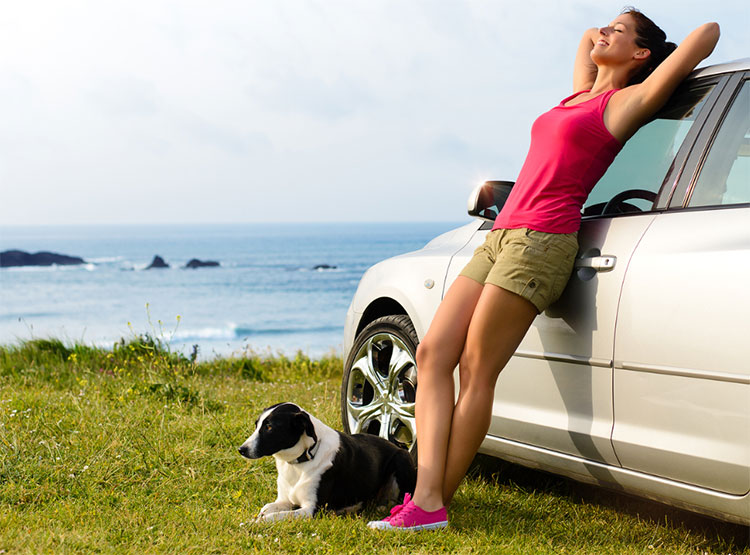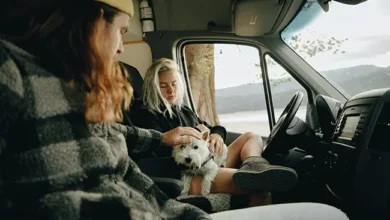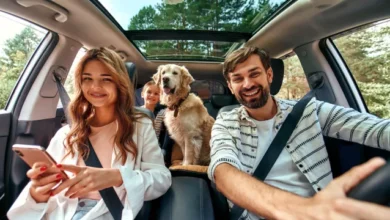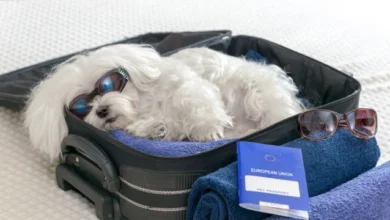
Traveling with a small dog can be a delightful adventure, filled with fun moments and heartwarming memories. Imagine exploring new destinations with your furry companion by your side, ready to sniff out every new scent and wag their tail at every passerby. However, it’s not all tail wags and happy barks—traveling with a small dog requires thoughtful planning and preparation.
From choosing the right travel method to packing all the essentials, there’s a lot to consider to ensure your trip goes smoothly. Whether you’re hitting the road, flying to an exotic location, or hopping on a train, each mode of travel comes with its own set of challenges and rewards. But don’t worry, with a bit of foresight and a lot of love, you can make the journey enjoyable for both you and your pint-sized pooch.
Choosing the Right Travel Method
When it comes to traveling with your small dog, choosing the right travel method is crucial for ensuring a safe and comfortable journey. Here are some important considerations for different modes of transportation:
Car Travel
Traveling by car with your small dog can be convenient and flexible, but it’s essential to prioritize safety and comfort.
Safety tips: using a crate or dog seatbelt
- Crate: Using a well-ventilated crate is one of the safest ways to transport your small dog. Ensure the crate is securely fastened and large enough for your dog to stand, turn around, and lie down comfortably.
- Dog Seatbelt: If you prefer not to use a crate, a dog seatbelt or harness can keep your dog secure. Attach the seatbelt to your car’s seatbelt system, ensuring your dog stays safely in place during the drive.
Comfort considerations: regular breaks, access to water, and a comfortable resting place
- Regular Breaks: Plan for regular stops, ideally every 2-3 hours, to allow your dog to stretch, relieve themselves, and burn off some energy.
- Access to Water: Keep a portable water bowl and bottled water handy to keep your dog hydrated throughout the trip.
- Comfortable Resting Place: Ensure your dog’s travel space is cozy. Use their favorite blanket or a comfortable bed to make them feel at home.
Dealing with motion sickness: gradual acclimatization and potential remedies
- Gradual Acclimatization: Introduce your dog to car travel gradually. Start with short trips and gradually increase the duration to help them get used to the motion.
- Potential Remedies: Consult your vet about remedies for motion sickness. Options include special diets, medications, or natural remedies like ginger.
Air Travel
Flying with your small dog requires careful planning and adherence to airline policies to ensure a smooth and stress-free experience.
Understanding airline policies: pet-friendly airlines and cabin vs. cargo options
- Pet-Friendly Airlines: Research and choose airlines that have a reputation for being pet-friendly. Policies and fees can vary, so check in advance.
- Cabin vs. Cargo: Many airlines allow small dogs to travel in the cabin if they fit in a carrier under the seat. Larger pets may need to travel in the cargo hold, which has different requirements and considerations.
Preparing for the flight: vet check-ups, necessary vaccinations, and documentation
- Vet Check-Ups: Schedule a vet visit before your trip to ensure your dog is healthy and fit to fly.
- Necessary Vaccinations: Make sure your dog is up-to-date on vaccinations required by the airline and your destination.
- Documentation: Gather all necessary documents, including health certificates, vaccination records, and any airline-specific forms.
Choosing the right carrier: size, ventilation, and comfort
- Size: Select a carrier that allows your dog to stand, turn around, and lie down comfortably.
- Ventilation: Ensure the carrier has adequate ventilation to keep your dog cool and comfortable.
- Comfort: Line the carrier with a familiar blanket or bedding to help your dog feel secure and at ease.
Public Transportation
Public transportation, such as buses, trains, and ferries, can be a practical way to travel with your small dog, but it’s important to research policies and ensure your dog’s comfort.
Researching pet policies for buses, trains, and ferries
- Pet Policies: Each mode of public transportation has its own rules regarding pets. Check the specific policies for your chosen mode of transport, including any size restrictions, fees, and required documentation.
- Advance Booking: Some services require advance booking for pets, so plan ahead to secure your spot.
Ensuring your dog is comfortable and secure
- Comfort: Use a carrier or travel bag designed for pets to keep your dog safe and comfortable. Ensure it is well-ventilated and provides enough space.
- Security: Keep your dog on a leash and close to you when not in the carrier to prevent them from getting lost or injured.
- Calming Measures: Bring along comfort items like a favorite toy or blanket, and consider using calming sprays or treats if your dog is anxious in new environments.
By considering these tips and guidelines, you can choose the best travel method for you and your small dog, ensuring a safe, comfortable, and enjoyable journey.
Packing Essentials
When traveling with your small dog, packing the right essentials is key to ensuring their comfort, health, and safety. Here’s a breakdown of what you should bring along:
Food and Water
Ensuring your dog stays well-fed and hydrated is crucial during your travels.
- Portable Bowls: Invest in collapsible or travel-friendly bowls for food and water. They’re lightweight, easy to pack, and convenient to use on the go.
- Enough Food for the Trip: Pack more than enough of your dog’s regular food to last the entire trip, plus a little extra in case of delays or emergencies. Sudden changes in diet can upset their stomach, so stick to what they’re used to.
- Bottled Water: Bring bottled water to ensure your dog drinks clean and safe water, especially if you’re traveling to places where the water quality might be uncertain.
Comfort Items
Keeping your dog calm and comfortable is essential for a stress-free journey.
- Favorite Blanket or Toy: Familiar items like their favorite blanket or toy can provide comfort and reduce anxiety. These items carry the scent of home and can make your dog feel secure in new environments.
Health and Safety
Being prepared for any health issues or emergencies is vital.
- First-Aid Kit: Assemble a first-aid kit specifically for your dog. Include bandages, antiseptic wipes, tweezers, and any other necessary medical supplies.
- Medications: Bring all necessary medications your dog might need, along with a few extra doses in case of delays. Don’t forget flea/tick prevention and any supplements they regularly take.
- Copy of Medical Records: Carry a copy of your dog’s medical records, including vaccination history and any prescriptions. This can be crucial if you need to visit a vet while away from home.
Hygiene
Maintaining your dog’s hygiene is important for their health and comfort, as well as for keeping your travel environment clean.
- Waste Bags: Pack plenty of waste bags for picking up after your dog. It’s essential for maintaining cleanliness and being a responsible pet owner.
- Grooming Supplies: Depending on the length of your trip, bring along basic grooming supplies such as a brush, nail clippers, and shampoo. Keeping your dog clean and groomed can prevent discomfort and health issues.
- Cleaning Wipes: Pet-friendly cleaning wipes can be very handy for quick clean-ups of muddy paws, spills, or any accidents that might happen during your travels.
Identification
Proper identification is crucial in case your dog gets lost.
- Collar with ID Tags: Make sure your dog wears a collar with up-to-date ID tags, including your contact information. This is the quickest way for someone to contact you if your dog gets lost.
- Microchip: Ensure your dog is microchipped and that the information is current. A microchip can be scanned by a vet or animal shelter to retrieve your contact details if your dog is found.
By packing these essentials, you’ll be well-prepared to handle any situation that might arise during your travels. Ensuring your dog’s comfort, health, and safety will make your trip more enjoyable and stress-free for both you and your furry friend.
Accommodations
Finding the right place to stay is a crucial part of traveling with your small dog. Ensuring your accommodations are pet-friendly and meet your needs can make your trip much more enjoyable. Here’s what you need to consider:
Pet-Friendly Hotels
Staying in a pet-friendly hotel can provide convenience and comfort, but it’s important to do your research.
Researching and booking pet-friendly accommodations in advance
- Early Planning: Start your search early to secure a spot in a pet-friendly hotel. Pet-friendly rooms can be limited, especially during peak travel seasons.
- Reliable Sources: Use websites and apps that specialize in pet-friendly accommodations, such as BringFido or PetsWelcome. These platforms provide detailed information and user reviews on pet policies and amenities.
Checking for pet amenities and policies: fees, size restrictions, and rules
- Pet Fees: Some hotels charge extra fees for pets, either per night or as a one-time cleaning fee. Make sure to factor this into your budget.
- Size Restrictions: Confirm if the hotel has any size or breed restrictions. Even if your dog is small, it’s always good to check.
- Hotel Rules: Familiarize yourself with the hotel’s pet rules. Some hotels may require pets to be crated when left alone in the room, while others might have specific areas designated for pets. Knowing these rules in advance can help avoid any surprises.
Vacation Rentals
Opting for a vacation rental can offer more space and a comfortable, home-like environment for both you and your dog.
Benefits of vacation rentals for more space and a home-like environment
- More Space: Vacation rentals often provide more living space than a standard hotel room, giving your dog more room to move around and play.
- Home-Like Comforts: Rentals typically come with amenities such as a kitchen, backyard, or patio, making it easier to maintain your dog’s regular routine and comfort.
- Privacy: With a vacation rental, you usually have more privacy and less noise, which can be beneficial if your dog gets anxious or excited by other guests.
Verifying pet policies and any additional charges
- Pet Policies: Contact the property owner or manager directly to confirm their pet policies. Ensure they allow pets and ask about any specific rules regarding where your dog can and cannot go within the property.
- Additional Charges: Check if there are extra cleaning fees or security deposits for pets. Some properties might have a refundable deposit or a small daily fee for bringing a pet.
- Property Reviews: Read reviews from other pet owners who have stayed at the rental. Their experiences can provide valuable insights into how pet-friendly and accommodating the property really is.
By taking these steps, you can find the right accommodations that will ensure both you and your small dog have a comfortable and enjoyable stay. Whether you choose a pet-friendly hotel or a spacious vacation rental, being well-prepared will help make your trip stress-free and memorable.
On-the-Go Care
Taking care of your small dog’s needs while you’re on the move is essential for ensuring their well-being and comfort throughout your trip. Here are some important points to consider:
Keeping your dog hydrated and fed on a schedule
- Hydration: Always have a portable water bowl and bottled water with you. Offer water frequently, especially during hot weather or after physical activity.
- Feeding Schedule: Stick to your dog’s regular feeding schedule as much as possible. This helps maintain their routine and prevents digestive issues. Use travel-friendly food containers to keep their meals fresh and convenient to serve.
Regular exercise: finding dog parks or safe walking areas
- Exercise Needs: Regular exercise is important to keep your dog healthy and happy. Look for nearby dog parks, walking trails, or open spaces where your dog can safely run and play.
- Local Recommendations: Ask locals or use pet-friendly apps to find good walking areas. Many cities have designated dog-friendly zones that are perfect for letting your dog stretch their legs.
Managing anxiety and stress: calming techniques and products
- Calming Techniques: Familiarize your dog with new environments gradually. Spend some quiet time with them in your hotel room or rental before exploring.
- Calming Products: Consider bringing calming aids such as anxiety wraps, pheromone sprays, or calming chews. These products can help reduce your dog’s stress during travel and in unfamiliar places.
- Routine and Comfort: Keep familiar items like their favorite blanket or toy nearby to provide comfort and a sense of security.
Health and Safety
Ensuring your dog’s health and safety is paramount when traveling. Proper preparation and awareness can help prevent issues and allow you to address any problems that arise effectively.
Pre-trip vet visit: vaccinations, flea/tick prevention, and a health certificate
- Vet Visit: Schedule a visit to your vet before your trip to ensure your dog is healthy and fit for travel. This is especially important if you’re flying or traveling internationally.
- Vaccinations: Make sure your dog’s vaccinations are up to date, including any additional vaccines required by your destination.
- Flea/Tick Prevention: Apply flea and tick prevention treatments before you leave to protect your dog from pests.
- Health Certificate: Obtain a health certificate from your vet if required. This document certifies that your dog is healthy and free of contagious diseases.
Recognizing signs of stress and illness: what to look out for and when to seek help
- Stress Signs: Be aware of signs of stress in your dog, such as excessive panting, drooling, shaking, or hiding. Address these signs with calming techniques or products.
- Illness Symptoms: Watch for symptoms of illness, including vomiting, diarrhea, loss of appetite, or lethargy. If any of these occur, seek veterinary help promptly.
Emergency contacts: knowing the location of nearby vets and emergency services
- Local Vets: Research and note the locations of nearby veterinary clinics at your destination. Knowing where to go in case of an emergency can save precious time.
- Emergency Services: Identify the closest emergency animal hospital. Keep their contact information and address handy in case you need urgent care for your dog.
- Pet Insurance: If you have pet insurance, make sure you have your policy details and know how to contact them for assistance while traveling.
By taking these steps to ensure on-the-go care and maintaining health and safety, you’ll be well-prepared to handle any situation that might arise during your travels. This preparation will help ensure that your small dog remains healthy, happy, and safe throughout your trip.
Tips for a Smooth Journey
Ensuring a smooth journey for both you and your small dog involves some proactive steps to acclimate, train, and maintain a routine for your pet. Here’s how you can make your travel experience as stress-free and enjoyable as possible:
Acclimating Your Dog: Familiarizing your dog with the carrier or car before the trip
- Carrier Familiarization: If you’ll be using a carrier, start by introducing it to your dog well before the trip. Leave it open in your home with some treats or toys inside to encourage your dog to explore it.
- Short Practice Trips: Take your dog on short car rides to get them used to the motion and environment. Gradually increase the length of these trips to build their comfort and tolerance.
- Positive Reinforcement: Use treats and praise to create positive associations with the carrier or car. This helps reduce anxiety and makes travel more enjoyable for your dog.
Training: Basic commands and good behavior in public places
- Basic Commands: Ensure your dog knows and responds well to basic commands like sit, stay, come, and leave it. These commands can help manage their behavior in new environments.
- Public Behavior: Practice good behavior in public places. Take your dog to parks or pet-friendly stores to help them get accustomed to being around other people and animals.
- Leash Training: Make sure your dog is comfortable walking on a leash without pulling or reacting aggressively. A well-behaved dog on a leash makes for a more pleasant travel experience.
Routine: Maintaining a routine to provide a sense of normalcy for your dog
- Feeding Schedule: Try to stick to your dog’s regular feeding schedule as closely as possible. This consistency helps keep their digestive system in check and provides a sense of normalcy.
- Exercise and Play: Maintain regular exercise and playtime routines. Familiar activities can help reduce stress and keep your dog happy and healthy.
- Sleep Schedule: Keep your dog’s sleep schedule consistent. Bring along their bed or blanket to help them feel secure and comfortable in new places.
Conclusion
Recap of key points for traveling with a small dog Traveling with a small dog requires thoughtful preparation and attention to detail. To ensure a smooth journey, remember to:
- Choose the right travel method and prioritize your dog’s safety and comfort.
- Pack all necessary essentials, including food, water, comfort items, health supplies, hygiene products, and identification.
- Book pet-friendly accommodations and check their policies in advance.
- Take care of your dog on-the-go by keeping them hydrated, fed, and exercised.
- Ensure their health and safety by visiting the vet beforehand, recognizing signs of stress or illness, and knowing where to find emergency services.
Encouragement to enjoy the journey and create lasting memories with your furry friend With the right planning and preparation, traveling with your small dog can be a wonderful and rewarding experience. Embrace the adventure, cherish the moments, and create lasting memories with your furry friend. Whether it’s exploring new places or simply spending quality time together, the journey will be a special one for both of you. Happy travels!



